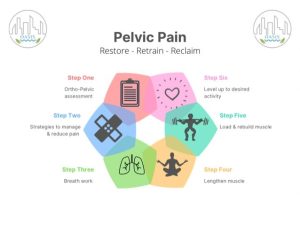By Amanda Regler, DPT and Sonya Worthy Okolo, PT
Did you know pelvic pain impacts 1 in 4 women worldwide? That means, at some point in life, 25% will experience pain that hinders sitting tolerance, sexual health, bladder or bowel elimination, or function during menstruation. According to a Chronic Pelvic Pain (CPP) Review by Lamvo et al in 2021, 40% of the laparoscopies and 12% of the hysterectomies performed in the U.S. are a result of CPP.
The American College of Obstetricians and Gynecologists describes CPP as noncyclic “pain symptoms perceived to originate from pelvic organs/structures typically lasting more than 6 months” or cyclical pain that has “significant cognitive, behavioral, sexual, and emotional consequences.” CPP can be multifactorial and difficult to diagnose and treat. In general, there are seven main types:
- Gynecological – Endometriosis, Adenomyosis, Fibroids, Post surgical scarring
- GI Related – Irritable Bowel Syndrome(IBS), Hernia
- Vascular – Pelvic Congestion Syndrome
- Psychological – Somatic Pain Syndrome due to history of abuse/trauma/distress
- Neurological – Pudendal Neuralgia (PN), Lumbar spine injury
- Urological – Prostatitis, Interstitial Cystitis (IC) or Bladder Pain Syndrome (BPS)
- Musculoskeletal – Pelvic Floor Dysfunction (PFD), Pelvic Girdle Pain (PGP), Fibromyalgia, Muscle Pains, Ehler’s Danlos Syndrome (EDS)

Patients are often frustrated by a perceived lack of treatment; however, pelvic floor therapy can help! The Oasis 3R Method (Restore, Retrain, Reclaim) is a comprehensive, holistic PT approach designed to improve your quality of life, foster healing and manage pelvic pain of all types.

Our Top Tips to Reduce Pelvic Pain:
- Stress Management – Stress can show up in the body in many ways, one of which is tight or clenched muscles. Performing daily body scans can help to identify and reduce this tension and improve overall stress. Scanning for tense muscles from head to toe during typical daily activities, like driving, cooking, reading, watching a movie. If you discover this trend, then make a conscious effort to relax them. This is a way to retrain your brain not to hold stress in the form of tension throughout your body.
- Sleep Hygiene – Strive for 7-8 hours per night of sleep for nervous system reset. Poor sleep quality contributes to raised cortisol levels, inflammation and pain increase. Strategies to improve sleep may include lowering the temperature, weighted blankets, nighttime meditations, and cutting screen time before bed. Magnesium glycinate is a supplement that helps your brain calm down and supports muscle relaxation.
- Constipation Management – Backed up stool puts more pressure on the bladder, uterus, and pelvic floor muscles triggering increased tension and spasm. Hydrate regularly, up to half of body weight in ounces for most. Strive to eat the rainbow with fruits and vegetables. Track your response to food to identify triggers of inflammation and gut issues. Prioritize bowel regularity to cleanse the body of toxins.
- Move more – Tight, congested muscles and irritated nerves need space, blood flow, and motion. Fitness should be low to moderate exertion to avoid increased inflammation of tissues. Yoga and mobility flows are great to nudge gently without aggravating pain.
- Schedule a Pelvic Floor Evaluation
- Our screening takes a deep look into lifestyle factors, such as nutrition, sleep, stress, activity, movement patterns and how they are hindering or helping to optimize pelvic health.
- Our “traditional” PT examination will uncover any orthopedic or neurological contributors taking a whole-body approach to assess the impact on the pelvic tissues.
- Our providers have specialized, advanced training to perform an internal pelvic floor assessment.
Taking all of these factors into consideration, we will develop a comprehensive treatment plan to address your unique impairments and meet YOUR goals. Ready to put an end to pelvic pain? Help is available for your most intimate concerns! Call 301-381-4551 to schedule a Pelvic Floor Evaluation.
——————————————————————————————————————————————————————————————————–
Huang G, Le A-L, Goddard Y, James D, Thavorn K, Payne M, et al. A systematic review of the cost of chronic pelvic pain in women. J Obstet Gynaecol Can. 2021.
Georgine Lamvu, MD, MPH1,2; Jorge Carrillo, MD1,2; Chensi Ouyang, MD1,2; et al, Chronic Pelvic Pain in Women A Review, JAMA. 2021;325(23):2381-2391. doi:10.1001/jama.2021.2631

